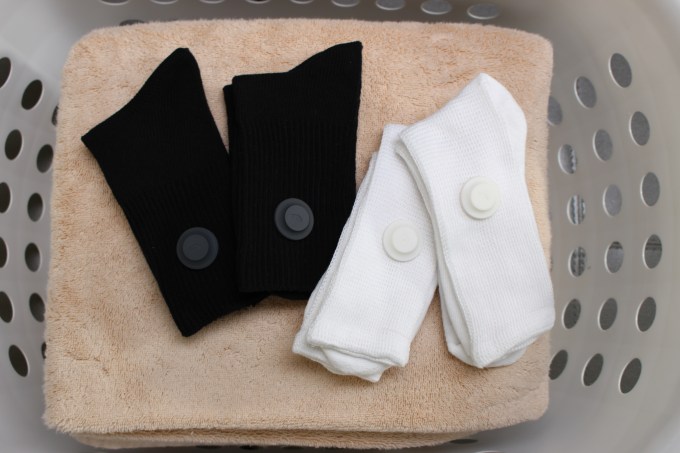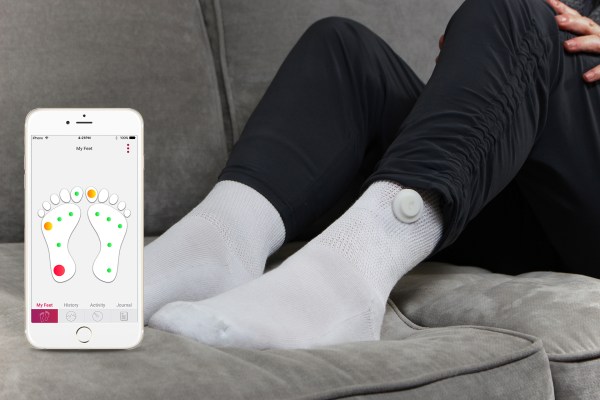Instead of tracking your health with a little band that’s on your wrist, Ran Ma thinks that the future is keeping track of your health — or at least parts of it — with technology that’s woven into the fabric of your clothes.
That’s the target of Siren Care, a wearable company that looks to weave electronic sensors into its clothing in order to track changes in a person’s health. The company is working on a sock that can track temperature changes in feet for diabetics, which can help figure out when things are starting to go wrong and the person needs to go to the doctor. Ma, who had previously studied wound care as part of her masters, thought this was the best place to start. Siren Care showed off the socks at a presentation at TechCrunch’s Hardware Battlefield at CES this year.
The sock is, well, a sock. It has a small device that protrudes from it that transmits information to the Siren Care app, which helps diabetic patients keep a close eye on what’s going on with the temperature changes in their feet. If there are any anomalies, they can take a look at what’s going on and figure out whether or not they need to go see a doctor before things get bad as a result of an injury that they weren’t keeping close tabs on.
[gallery ids="1435469,1435470,1435471,1435468"]
Those injuries can be a result of something as simple as leaving a sock in a shoe, but the patient won’t be aware of what’s going on, Ma said. As a result, the problem can quickly spiral out of control and lead to a trip to the doctor or even worse. The goal is to ensure that, early on, that simply doesn’t happen and diabetic patients are able to have an extra tool to help manage it.
Throughout the launch and development, Siren Care will be working to gauge the overall change in a person’s health through what’s going on with their feet. That means that, instead of simply looking for a snapshot — like a spike in temperature or seeing an injury — it’ll be looking at trends and trying to get ahead of potential injuries, Ma said.
“Right now based on research there is an exact number that dictates when you have damage,” Ma said. “We think you can personalize that. Previous devices are a one-off measurement — how do you know what happened before or after? How do you know that wasn’t noise? We think we can do better because we’re taking continuous measurements throughout the day. Maybe your foot, one is always warmer than the other. We can account for that. Injury is not a spike in temperature, it’s a sustained average difference.”

To be sure, there’s a ton of interest in “smart” clothing that has electronics embedded in them. We’ve seen Kickstarter projects pop up like Enflux, which focuses on workouts, as well as other “connected” clothing like a jacket that’s built by Google and Levi’s. The technology is basically advancing to the point that the manufacturing process is getting easier to weave these kinds of electronics into fabrics in order to detect various changes around a person’s body.
The company went through 500 Startups and presented in October last year, and was definitely one of the standouts in the crowd. Siren Care for now works as a subscription model. The socks are machine washable, Ma said, and every six months Siren Care replaces the socks. That’s about average for other diabetic socks used to help spot injuries, though they can end up showing up later and it may be very far along and should have been treated earlier.
In the end, the company doesn’t plan at stopping at a sock for diabetics. The company is hoping to apply the technology — and the data it acquires through it — to build other kinds of smart clothing that is able to use the same processes of embedding sensors into fabrics. The applications of that are naturally pretty wide, so Siren Care is better off starting off with something they know they can tackle first, Ma said.
“I don’t see ourselves as a diabetic foot company. I think we’re a data company and next-generation wearables,” Ma said. “The next generation will be targeted toward chronic disease, aging, health management — and also in a way that’s designed to fit into your lives. Instead of having bands, it should be the clothes you wear every day.”
